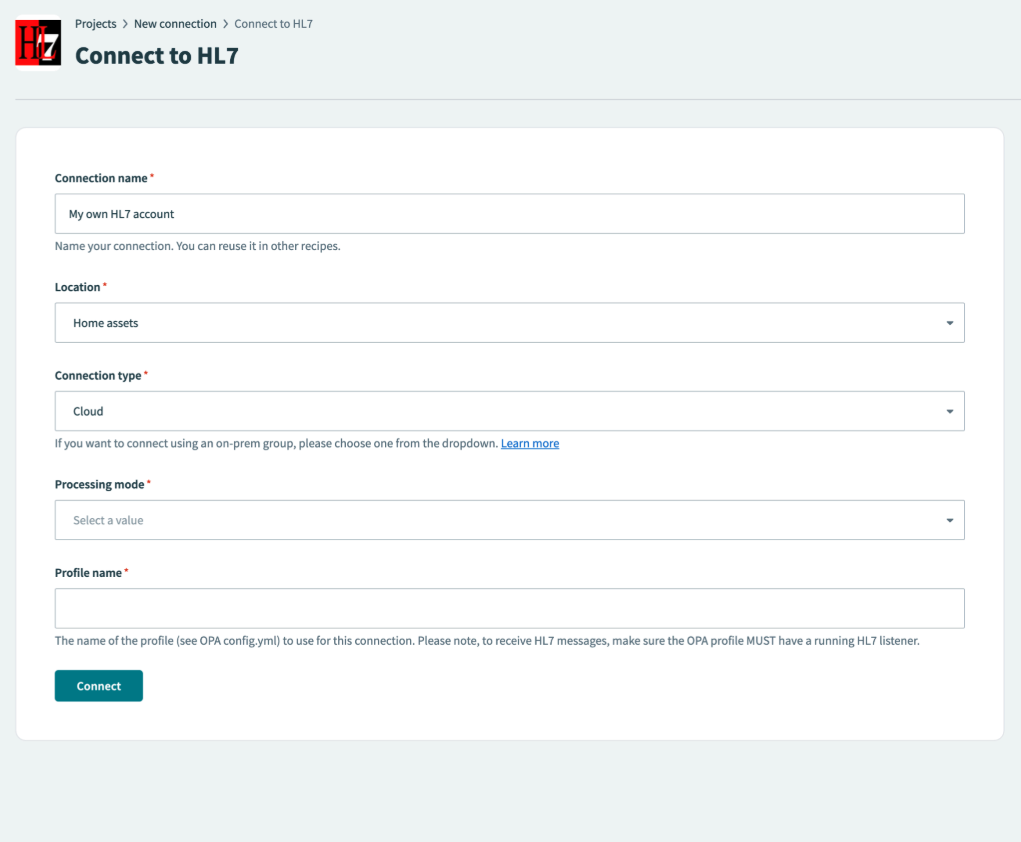# HL7
HL7 (opens new window), or Health Level Seven, is a set of international standards for the exchange, integration, sharing, and retrieval of electronic health information. HL7 messages are a key component of this standard, and serve as the format for exchanging information between healthcare applications. These messages are structured in a way that allows different systems to understand and interpret the data consistently. You can use HL7 messages for various purposes, including transmitting patient demographic information, laboratory results, clinical observations, and administrative data.
The HL7 Workato connector allows you to send and receive HL7 messages in different versions, and includes a corresponding OPA extension.
# Prerequisites
You must complete the following prerequisites before you install the HL7 connector:
Set up an on-prem agent (OPA). You can use either a cloud profile or connection profile. Both options require the ability to manually edit the
config.ymlfile on the machine where the OPA is installed.OPA versions lower than 23.0 require you to install version 17 or higher of the Java SDK (opens new window). Refer to the On-prem agent version notes for more information.
# Installation
Complete the following steps to install the HL7 connector:
Locate the OPA directory on your filesystem. Typical locations are:
| Operating system | Location |
|---|---|
| Unix-like operating systems | /opt/workato |
| Windows | C:\Program Files\Workato Agent |
| macOS | Location varies |
Ensure version 17 or higher of the Java SDK (opens new window) is installed if you're using an OPA version lower than 23.0. The following are the default JDK installation locations:
| Operating system | Location |
|---|---|
| Unix-like operating systems | /usr/lib/java |
| Ubuntu | /usr/share/java/ |
| Windows | C:\Program Files\Java\jdk-<release> |
| macOS | Location varies based on distribution. Example: /Library/Java/JavaVirtualMachines/jdk-17.jdk/Contents/Home |
Download the HL7 extension (opens new window).
Download the file and extract the package to $OPA/ext where $OPA refers to your OPA installation directory. Learn more.
Navigate to the OPA configuration file at $OPA/conf/config.yml. To use the HL7 extension, you must update the configuration file according to the following instructions. This step applies whether the OPA is configured using a cloud profile or a connection profile.
server:
classpath: /opt/workato-opa/ext # Set the classpath to the path of the folder where the HL7 extension JAR files are located
extensions:
# HL7-Profile including a listener to receive messages
hl7: # Name of the connection profile to be used, when creating a connection
controllerClass: com.workato.extension.hl7.ExtensionController
localPort: 1011 # Listening port to receive messages
webhookURL: https://webhooks.workato.com/users/... # The webhook URL to receive the HL7 message
remotePort: 1011 # Port to send messages
remoteHost: localhost # Hostname to send messages
tls: false
# Encoding used for sending and receiving messages. Possible values UTF-8, ISO-8859-1, UTF-16, ...
# encoding: ISO-8859-1
# HL7-Profile WITHOUT a listener, which allows to send messages only
hl7_no_listener:
controllerClass: com.workato.extension.hl7.ExtensionController
remotePort: 1011
remoteHost: localhost
tls: false
# Encoding used for sending and receiving messages. Possible values UTF-8, ISO-8859-1, UTF-16, ...
# encoding: ISO-8859-1
Install and release the connector from the Community Library.
# Connection setup
Complete the following steps to create an HL7 connection in Workato:
Provide a Connection name that identifies which HL7 instance Workato is connected to.
 HL7 connection configuration
HL7 connection configuration
Use the Location drop-down menu to select the project where you plan to store the connection.
Use the Connection type drop-down menu to select the on-prem group, where your HL7 extension is configured.
Use the Processing mode drop-down menu to select the HL7 processing ID you plan to use. Options are: Debugging, Production, and Training.
Provide your Profile name. To receive HL7 messages, the OPA profile MUST have a running HL7 listener.
Click Connect.
Last updated: 10/20/2025, 10:07:56 PM